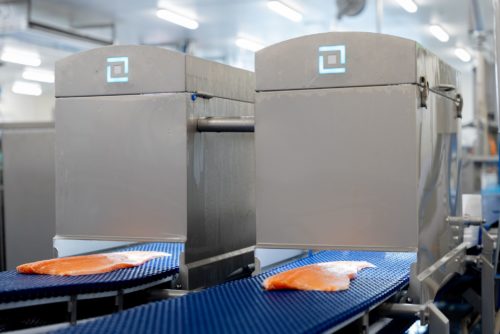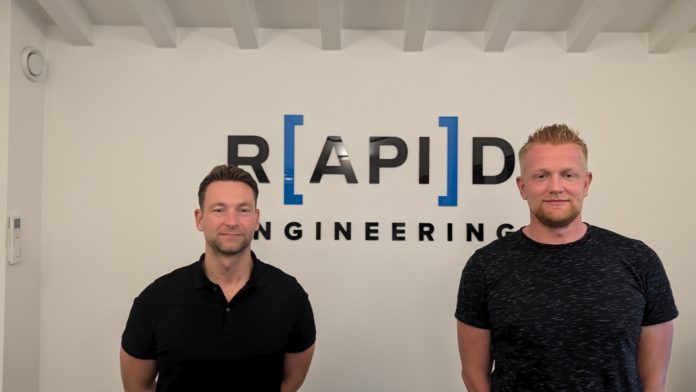Visscher and RapiD are seeking to revolutionise the world of salmon quality control.
RapiD Engineering, a Dutch technology company based in Urk, has partnered with Visscher Seafood to introduce an AI-based quality control system aimed at transforming salmon processing.
The system, known as RapiD Vision Quality Control, leverages artificial intelligence (AI), 3D vision, and image analysis to detect defects in real-time, offering a new level of precision in product inspection. The technology has been fully operational in one of Visscher Seafood’s facilities for several months and is expected to improve both product quality and purchasing decisions, providing significant benefits for processors and suppliers alike.
Tim Brouwer, CEO of Visscher Seafood, reflected on the collaboration’s beginnings. “About a year ago, we sat down with RapiD, and we came up with the idea of using their existing technology as a quality inspection tool, working with what they already had in place,” Brouwer said. “We started some trials in our facility, and now, 12 months later, it’s fully operational.”

The RapiD Vision system integrates seamlessly with Visscher’s existing machinery and Enterprise Resource Planning (ERP) systems, ensuring that product quality is tracked and linked back to suppliers. One of its key advantages is the ability to differentiate between species, measure volumes, and detect deformities, which enhances the efficiency of robotic operations.
The result is a streamlined quality control process that provides detailed insights into the products, allowing for more informed purchasing decisions based on the actual condition of the fish.
Revolutionizing quality control and purchasing decisions
Brouwer highlighted the profound impact this technology is already having on Visscher’s operations, particularly in purchasing. “The biggest value lies in measuring the raw material,” he said. “You could have a supplier that’s five cents cheaper every week, but if you factor in the deformities, you could actually be losing 10 or 15 cents. On the other hand, a supplier who’s more expensive might turn out to have fantastic quality with much fewer deformities, which means it pays off to work with them. This system helps us make much better purchasing decisions.”
The data collected by RapiD Vision also helps the company spot trends related to seasonal and regional variations in fish quality. “We can now say, for example, this season or this region performs better than others. It makes it easier to choose the right suppliers based on solid data,” Brouwer added.
The system also facilitates clearer discussions with suppliers when issues arise. “Before, we might have 10 or 20 pictures to back up a claim, and that’s often not enough evidence. But now, we can provide a link with all the evidence, showing each fillet with a defect. There’s no room for discussion. The only thing to debate is the discount,” Brouwer said.
Establishing industry standards for defect pricing
One of the long-term goals for Visscher and RapiD is to use the RapiD Vision system to help establish standardized pricing for defects in the seafood industry. This would involve setting clear guidelines for how much processors should discount products based on specific types of deformities, such as blood spots or melanin.
Brouwer explained, “There’s often a lot of debate about how much to discount for defects. We’re hoping this system can help set standards. For example, if you’ve got a blood spot or cartilage larger than four square centimeters, we can agree on a percentage discount. It would benefit everyone if we had a standardized system in place.”
Brouwer acknowledged that there may be some initial resistance from suppliers, but he believes the standardization would benefit the entire industry.
“At first, there might be some pushback, but ultimately everyone benefits from having clear, consistent standards. It makes the whole process more transparent,” he told SalmonBusiness.
The potential to establish industry-wide standards is something that excites Riekelt Post, co-founder of RapiD Engineering.
“We’re hoping this technology gets adopted more broadly, not just by Visscher, but by the whole industry. If we can set objective criteria for things like blood spots or cartilage, it will bring a lot of clarity to the supply chain,” he said.
Adapting AI for the seafood industry
The technology behind RapiD Vision has been several years in the making. “We started developing this system five or six years ago, initially focusing on robotic applications for the fish industry. With AI, we were able to classify fish and detect deformities better,” Post explained. “When Visscher asked us to go one step deeper, looking at the defects in finer detail, we were able to adapt our system to meet their needs.”
Post emphasized that one of the key strengths of the system is its ability to evolve continuously. “AI is developing quickly, and we’re able to implement new technology as it becomes available. This system is always getting better because it’s updated regularly. It’s not just a one-off product—it’s something that grows with the needs of the customer,” Post added.
This flexibility and continuous improvement make RapiD Vision a valuable tool for processors looking to stay ahead of market demands. “The system is a living product, and that’s what makes it so valuable. As the software evolves, our quality control processes get better and better,” said Brouwer.
Future plans and broader adoption
Visscher Seafood is already looking to expand the use of RapiD Vision beyond its initial facility. “We’re operational in one facility now, and we hope to roll it out to the other two in the near future,” Brouwer said.
He also expressed hope that other companies in the seafood industry will adopt the technology. “We believe this system can benefit the whole industry by improving transparency and setting new standards for quality control.”
For Post, the partnership with Visscher represents just the beginning. “The insights we’re providing have a lot of value, not just for Visscher but for the entire industry. We want to see these standards applied more broadly, making the market more transparent and fair for everyone involved,” Post concluded.


